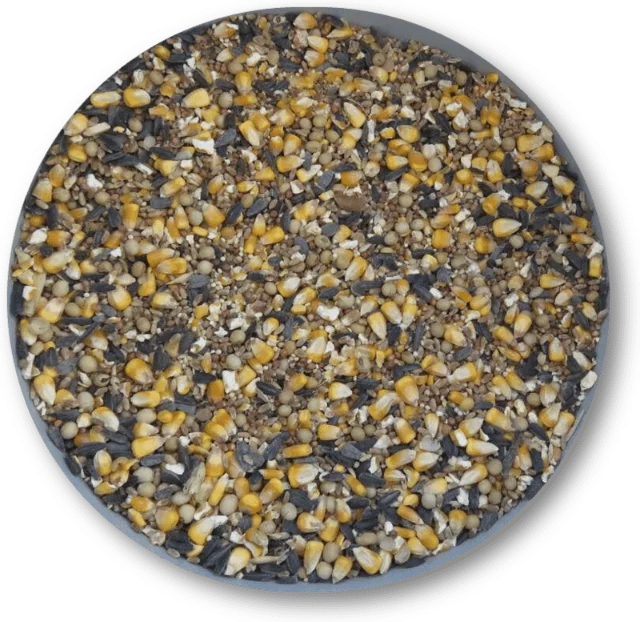The Feed Mixture varies depending on the time of year, age, and activity of the pigeon. Don’t forget, always include Grit and have fresh, clean water. So, let’s break it down and get right into it.
Grit Mixture – What is it and Why do they need it:
Grit is essential to their digestive system. It’s needed to break down and digest the grains they eat.
- Granit Chips – grind up the grains and corn in their gizzard.
- Oyster Shell – calcium for their bones
- Charcoal – provides additional protection by cleaning the crop and reducing harmful bacteria. Most don’t know about this.
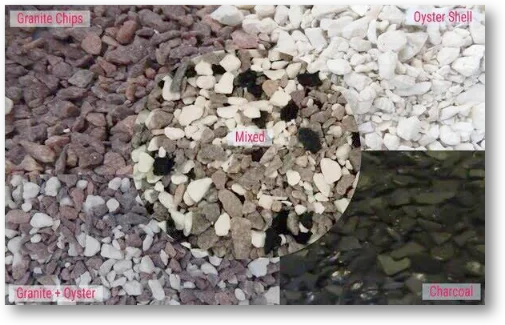
NOTE: Before I continue… NEVER Feed Birds rotten or moldy corn/grains, nor any food that has evident moisture in it. It WILL make your birds Sick, and pigeons CAN’T FLY SICK.
FEED Mixtures – What Do We Feed Our Birds:
- WHOLE Corn – from local farmers or local Coop Feed Mill
- Wheat
- Black Sunflower Seeds
- ROASTED Soybeans – Protein – Must be Roasted
- Red Milo
- Safflower
- SHELLED Peanuts
- SHELLED Sunflower Seeds or called Hearts and Chips
- Fruit N’ Nut mixture
- White Millet (sometimes, but no real nutritional value)
NOTE: I DON’T buy or feed birds Cracked Corn…
- They don’t like it.
- It’s too sharp to regurgitate to feed their babies.
- Cracked Corn also has the potential to breed bacteria and could cause Canker disease in birds. Add Charcoal to Grit.
- If I bought feed that already had cracked corn in it, they would eat everything except the cracked corn.
- Frankly, my Chickens won’t even eat cracked corn.
- They want whole, small-kernel corn.
Seasonal Feed – What & When Guide of How we feed:
1.) Winter Feed –
Keep in mind that we live in the cold tundra of Northern Minnesota, where snow can be plentiful, temperatures can drop to dangerously low levels, and winds can be fierce. LoL… Let’s not forget about the wicked winds we get up here, especially where we are near open fields and farm land. Our birds need all the warmth we can give them. (Read article on how to winterize a coop.)
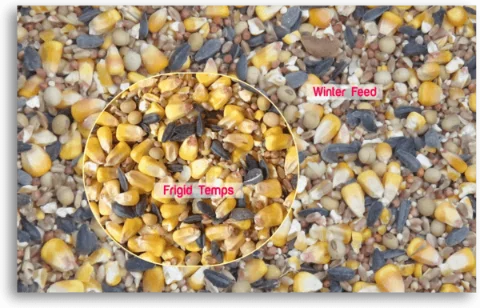
- Whole Corn – it’s like eating butter, high in fat to keep them warm. Winter mix contains roughly 65-85% corn
- Wheat
- Red Milo
- Black Sunflower Seeds
- Roasted Soybeans – good source of Protein
2.) Spring Feed –
Weather is getting warmer, cool days and cold nights
- Whole Corn – Spring mix contains roughly 40-50% corn
- Wheat
- Red Milo
- Black Sunflower Seeds
- Roasted Soybeans
- Shelled Sunflower Seeds (Hearts and Chips)
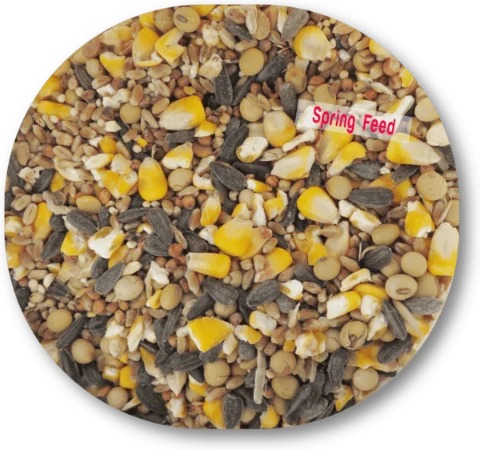
3.) Summer Feed –
Hot Weather, Breeding Time, Raising Babies, Training and Flying Young Kits.
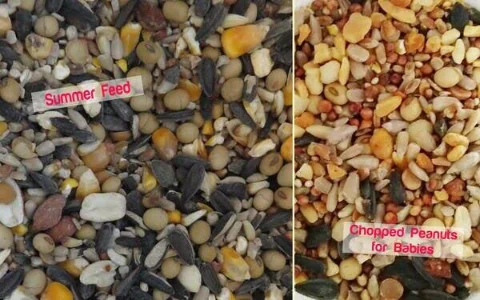
- Whole Corn SOMETIMES – roughly 5-10% if at all. When it gets steamy, humid, and hot, birds don’t want to eat corn. I gauge this by what they leave behind in the feeders when they are done eating. If corn is left, then I’ll leave it out of the mix from then on. If the weather cools for a few days and I notice the birds seem hungry, then I’ll add a little corn to see if they eat it. Like I said, just gauge their behavior; they will tell you.
- Black Sunflower Seeds (not as much since I also use shelled)
- Wheat
- Red Milo
- Fruit N’ Nut
- Shelled Sunflower Seeds (also called Heart and Chips)
- Shelled Peanuts (but not the big size unless you chop them)
- Roasted Soybeans
- Safflower (they really like this stuff)
NOTE: Summer Feed is VERY IMPORTANT if you are breeding and raising babies. Not to mention, for strong, healthy birds, the babies will need plenty of nutrients and proteins in order to be weaned, trained, and flown.
4.) Fall Feed –
It’s still nice, but getting cooler. Pigeons MOULT starting in Aug.-Nov., so they will need a lot of protein-rich foods to grow their winter coat of new feathers.
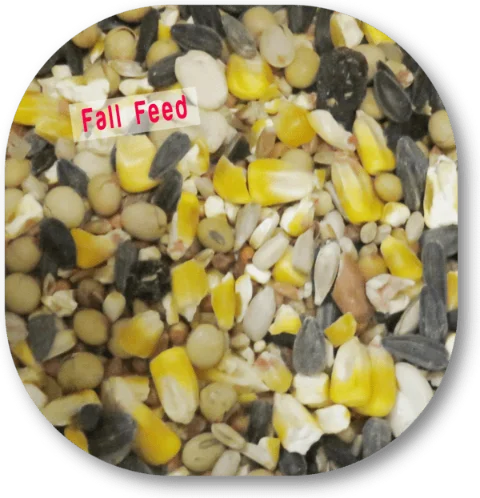
- Whole Corn – gradually changing the amount as the weather changes – 20% to 30% to 40% you get the idea. Again, just gauge your birds’ behavior and they will tell you what they need.
- Wheat
- Red Milo
- Black Sunflower Seeds
- Roasted Soybeans
- Peanuts
- Hearts and Chips
- Safflower
When and How Many Times a Day Do We Feed Birds:
Winter – Once a day between 3-4pm (remember, it gets dark early around 4:30-5pm) so be sure to give birds enough time to eat and drink before closing them up before dark.
Spring – Once a day around 4-5pm
Summer – Because it’s baby time, we feed Breeder Coop both in the morning and in the evening. However, the Flyer Coop is only fed once a day, in the evening (during dinner). If you feed your flyers earlier and then decide to let them out to fly, you may find they are reluctant to come back in quickly when you are calling them. Food is a great training incentive to teach birds they will get fed as soon as they come down and go in. They lose that motivation to come in when called if they are not hungry.
Fall – If I still have babies or really young ones, then I will still feed them twice a day. The same goes for the ones that are heavily moulting; I will continue to feed them twice a day. Note that if I am feeding them twice a day to give them the added nutrients they need to grow nice new feathers, then I don’t let them out to fly; they will be let into the attached Avery/fly pen instead. Each one of my fly pens is bigger than most people’s living rooms. This way, they still get plenty of exercise and fresh air. Other than that, I only feed them once a day, in the evening (dinner time), after flying. Now, keep in mind when letting them out during a moult, they may be reluctant to fly without new feathers and may then choose to simply stick around sitting on the roof of your coop.
In case I wasn’t clear yet, Never let your birds out to fly After you feed them. Always let them out to fly on an empty stomach, and then call them down and in to eat. Never leave food in their feeders overnight. Never allow feed to be scattered on the floor, where it gets poop on it. They will eat it at some point and most likely become ill; you will then be left wondering why this or that bird is ill. Clean Up the floor if you see food lying around. You certainly don’t want to attract and feed mice, either.
In Conclusion:
Well, I hope this guide helps. I know the internet has many “gurus” who would have you believe their way is the only way. But I can honestly say that, way back in the day, when I was first starting out with rollers, I implemented some of their strategies and advice. Well, to put it mildly, most of the advice I tried was short-lived. My dad (may God rest his soul) was a well-known racing homer champion. He grew up in Germany and started learning the ins and outs of raising pigeons from the old timers there as a kid. He brought that knowledge with him to the States when he was a young man. He got me started when I was very young, teaching me how to care for his racing homers while he was away for work. He taught me everything he knew about pigeons. Yet, when I decided to venture into flying rollers all those many years ago, I looked to the roller “gurus” for advice. It was only a short window of time before I realized my dad knew best. Animals seem to know what their own needs are, so from that point on, I’ve been following my birds’ lead by observing their health and performance to come up with the best way of feeding and caring for them.
Now understand, I am not saying the other ways are wrong; I am simply saying I found what works best for my own birds. I do NOT leave my birds hungry. In fact, I will go around again after feeding them to see if any of them are still looking for food. If so, I put down a little more until I no longer see anyone at the feeder. If there is any food left over at that point, rest assured that I will empty the feeders before locking them in for the night. What can I say? My birds have quite the life… LoL … That’s all for now; drop us a line if you have any questions.

